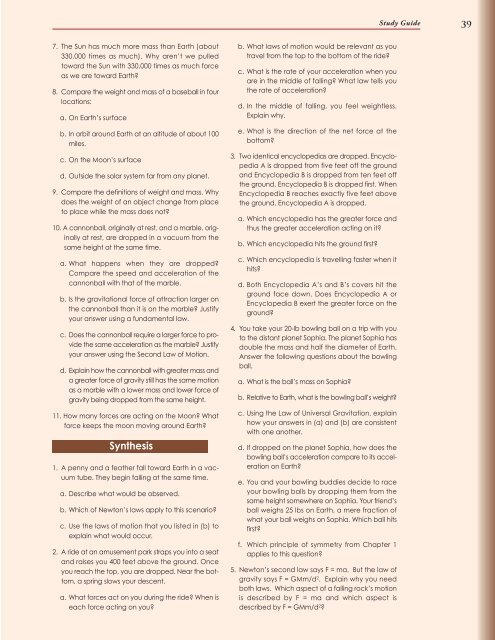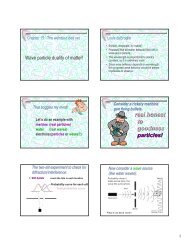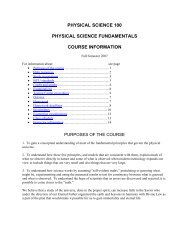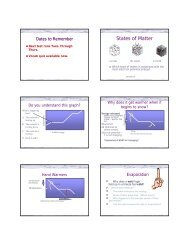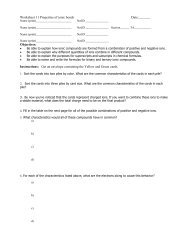knowledge, science, and the universe chapter 1 - Physical Science ...
knowledge, science, and the universe chapter 1 - Physical Science ...
knowledge, science, and the universe chapter 1 - Physical Science ...
Create successful ePaper yourself
Turn your PDF publications into a flip-book with our unique Google optimized e-Paper software.
Study Guide 39<br />
7. The Sun has much more mass than Earth (about<br />
330,000 times as much). Why aren’t we pulled<br />
toward <strong>the</strong> Sun with 330,000 times as much force<br />
as we are toward Earth<br />
8. Compare <strong>the</strong> weight <strong>and</strong> mass of a baseball in four<br />
locations:<br />
a. On Earth’s surface<br />
b. In orbit around Earth at an altitude of about 100<br />
miles.<br />
c. On <strong>the</strong> Moon’s surface<br />
d. Outside <strong>the</strong> solar system far from any planet.<br />
9. Compare <strong>the</strong> definitions of weight <strong>and</strong> mass. Why<br />
does <strong>the</strong> weight of an object change from place<br />
to place while <strong>the</strong> mass does not<br />
10. A cannonball, originally at rest, <strong>and</strong> a marble, originally<br />
at rest, are dropped in a vacuum from <strong>the</strong><br />
same height at <strong>the</strong> same time.<br />
a. What happens when <strong>the</strong>y are dropped<br />
Compare <strong>the</strong> speed <strong>and</strong> acceleration of <strong>the</strong><br />
cannonball with that of <strong>the</strong> marble.<br />
b. Is <strong>the</strong> gravitational force of attraction larger on<br />
<strong>the</strong> cannonball than it is on <strong>the</strong> marble Justify<br />
your answer using a fundamental law.<br />
c. Does <strong>the</strong> cannonball require a larger force to provide<br />
<strong>the</strong> same acceleration as <strong>the</strong> marble Justify<br />
your answer using <strong>the</strong> Second Law of Motion.<br />
d. Explain how <strong>the</strong> cannonball with greater mass <strong>and</strong><br />
a greater force of gravity still has <strong>the</strong> same motion<br />
as a marble with a lower mass <strong>and</strong> lower force of<br />
gravity being dropped from <strong>the</strong> same height.<br />
11. How many forces are acting on <strong>the</strong> Moon What<br />
force keeps <strong>the</strong> moon moving around Earth<br />
Syn<strong>the</strong>sis<br />
1. A penny <strong>and</strong> a fea<strong>the</strong>r fall toward Earth in a vacuum<br />
tube. They begin falling at <strong>the</strong> same time.<br />
a. Describe what would be observed.<br />
b. Which of Newton’s laws apply to this scenario<br />
c. Use <strong>the</strong> laws of motion that you listed in (b) to<br />
explain what would occur.<br />
2. A ride at an amusement park straps you into a seat<br />
<strong>and</strong> raises you 400 feet above <strong>the</strong> ground. Once<br />
you reach <strong>the</strong> top, you are dropped. Near <strong>the</strong> bottom,<br />
a spring slows your descent.<br />
a. What forces act on you during <strong>the</strong> ride When is<br />
each force acting on you<br />
b. What laws of motion would be relevant as you<br />
travel from <strong>the</strong> top to <strong>the</strong> bottom of <strong>the</strong> ride<br />
c. What is <strong>the</strong> rate of your acceleration when you<br />
are in <strong>the</strong> middle of falling What law tells you<br />
<strong>the</strong> rate of acceleration<br />
d. In <strong>the</strong> middle of falling, you feel weightless.<br />
Explain why.<br />
e. What is <strong>the</strong> direction of <strong>the</strong> net force at <strong>the</strong><br />
bottom<br />
3. Two identical encyclopedias are dropped. Encyclo -<br />
pedia A is dropped from five feet off <strong>the</strong> ground<br />
<strong>and</strong> Encyclopedia B is dropped from ten feet off<br />
<strong>the</strong> ground. Encyclopedia B is dropped first. When<br />
Encyclopedia B reaches exactly five feet above<br />
<strong>the</strong> ground, Encyclopedia A is dropped.<br />
a. Which encyclopedia has <strong>the</strong> greater force <strong>and</strong><br />
thus <strong>the</strong> greater acceleration acting on it<br />
b. Which encyclopedia hits <strong>the</strong> ground first<br />
c. Which encyclopedia is travelling faster when it<br />
hits<br />
d. Both Encyclopedia A’s <strong>and</strong> B’s covers hit <strong>the</strong><br />
ground face down. Does Encyclopedia A or<br />
Encyclopedia B exert <strong>the</strong> greater force on <strong>the</strong><br />
ground<br />
4. You take your 20-lb bowling ball on a trip with you<br />
to <strong>the</strong> distant planet Sophia. The planet Sophia has<br />
double <strong>the</strong> mass <strong>and</strong> half <strong>the</strong> diameter of Earth.<br />
Answer <strong>the</strong> following questions about <strong>the</strong> bowling<br />
ball.<br />
a. What is <strong>the</strong> ball’s mass on Sophia<br />
b. Relative to Earth, what is <strong>the</strong> bowling ball’s weight<br />
c. Using <strong>the</strong> Law of Universal Gravitation, explain<br />
how your answers in (a) <strong>and</strong> (b) are consistent<br />
with one ano<strong>the</strong>r.<br />
d. If dropped on <strong>the</strong> planet Sophia, how does <strong>the</strong><br />
bowling ball’s acceleration compare to its acceleration<br />
on Earth<br />
e. You <strong>and</strong> your bowling buddies decide to race<br />
your bowling balls by dropping <strong>the</strong>m from <strong>the</strong><br />
same height somewhere on Sophia. Your friend’s<br />
ball weighs 25 lbs on Earth, a mere fraction of<br />
what your ball weighs on Sophia. Which ball hits<br />
first<br />
f. Which principle of symmetry from Chapter 1<br />
applies to this question<br />
5. Newton’s second law says F = ma. But <strong>the</strong> law of<br />
gravity says F = GMm/d 2 . Explain why you need<br />
both laws. Which aspect of a falling rock’s motion<br />
is described by F = ma <strong>and</strong> which aspect is<br />
described by F = GMm/d 2


